
By Sankalp Singh
The Amazon once hailed as the World’s ‘lungs’ is now but a major source of carbon emitter. Recent estimates suggest that Amazon rainforest has started emitting Carbon Dioxide, instead of taking it in. Home to about 30 million species and nearly one-fifth of the world’s land species, the Amazon is family to different biodiversity that are interlinked. Nearly twice the area of Indian subcontinent, its sprawling biota of 6 million square kilometer itself reveals a lot about the environmental importance it surrounds itself to.
Countries that border The Amazon have not taken it as their urgent priority to save the only carbon sink that could have mitigated the climate catastrophe in its entirety on land.
Since 1960, Tropical Trees, Dense forests, intensive vegetation, and high intensity of species have saved this rainforest from encroachments by anthropocentrism. If the issue of Amazon emitting Carbon is concerned, it is safe to say that Climate catastrophe has reached its tipping point. Brazil was directed to stop its developmental activities in these forests in order to save the Amazon, but now that is not the only concern.
Recent studies link the depletion of the Amazon to regular forest fires, warm temperatures, continuous dry conditions, and deforestation. If we talk about Geography, The Amazon is not only restricted to South America alone. Being called the World’s Lungs, it has impact almost in other continents. For Instance, North America is the immediate neighbor to the Amazon. Countries like Mexico and Colombia share borders through a narrow strip of lands.
According to the World in Data, significant quantity of deforestation in eastern and south eastern Brazil, plus the industrialization in Bolivia for Lithium has led to the Forests turning into carbon emitters than sinks. Of course, these are not the only two reasons for the Amazon.
Due to longer lengths of climate heating, The Amazon has seen forest fires on a stretched scale. Since the Amazon is interconnected with other vegetation and trees, so deforestation in one area leaves the other area vulnerable to other climate problems. Moreover, species richness and evenness are put to question. One specie getting affected by forest fires leaves the other consumer of that specie susceptible to starvation. Their deaths lead to carbon emissions. Moreover, scavengers present in abundance leads to increase in detritus content, in turn leading to further carbon emissions.
Some of the common reasons often cited in texts about deforestation are related to developmental activities in South America. Other reasons are the establishment of railway lines between Central and South America. Railway lines, while necessary for logistics carry a good intention. However, that very intention also leads to unintended consequence of deforestation of the Amazon. Even the city of Mumbai had to shed over thousands of trees for its metro rail project[1].
Let us also not forget the other devastating consequence of the Amazon getting depleted. Being closed canopy forests, the trees are densely packed. These trees help the regions of adjacent areas in South America from frequent rainfalls that are more than 200 cm. Once these trees are off the area, we can expect frequent floods, particularly in the lower riparian countries of Paraguay and Uruguay.
The world is experiencing around 1 degree Celsius of continuous warming since the 18th century, or the Industrial revolution in common parlance. If it comes to the Amazon, years of rapid deforestation and fires in the Amazon has led to frequent drier season and longer summer temperatures, leading to drought like phenomena. This is not due to industrial activity alone, but also due to the unending rise of consumerism. In terms of defining the source of depletion, Brazil is not to be blamed alone. Even the current Brazilian president was respected for sending military to the Amazon to contain or even stop deforestation[2].
All is not the end here. We can still be active here. Using the platform of both REDD+ and UNFCCC COP 26 at the Glasgow[3], we can aim to synergize the able thought leaders to mobilize resources at the emergency.
The Amazon is not a homogenous rainforest area; therefore it requires extensive study on the conservation side. The strategy that could work for eastern Amazon enclosing Bolivia, Peru, and Ecuador might not exactly replicate for Western Amazon that is adjacent to Brazil, Argentina, and Paraguay. We are at the tipping point to completely extinguish our world’s lungs. It is time to act now. Dear COP26, You have an urgent task cut out. Listen to this issue and act soon. We cannot borrow heavily from our future children at such a rapid scale. Sustainable development is the 911 answer.
References:
[1] https://mumbai.citizenmatters.in/what-can-be-done-about-forest-fires-in-aarey-24784
[2] McCoy, T. The Washington Post. Bolsonaro sent soldiers to the Amazon to curb deforestation. Here’s how the effort failed.https://www.washingtonpost.com/world/the_americas/brazil-bolsonaro-military-amazon-deforestation/2021/01/03/cde4d342-3fc9-11eb-9453-fc36ba051781_story.html
[3] https://sdg.iisd.org/events/2021-un-climate-change-conference-unfccc-cop-27/




